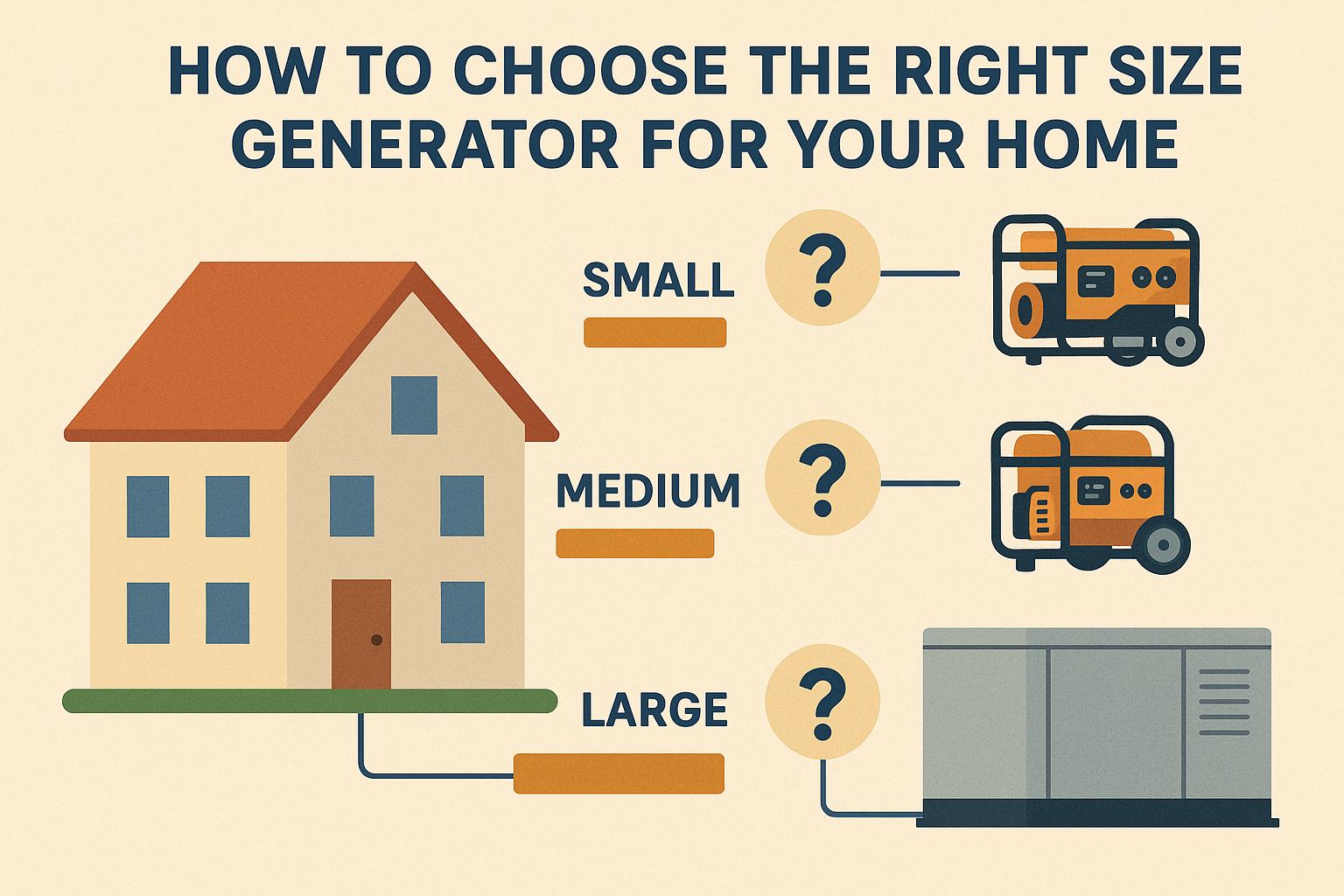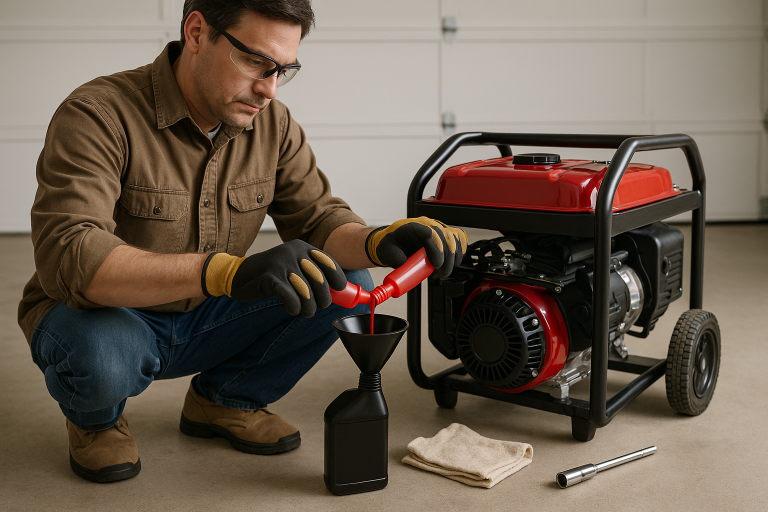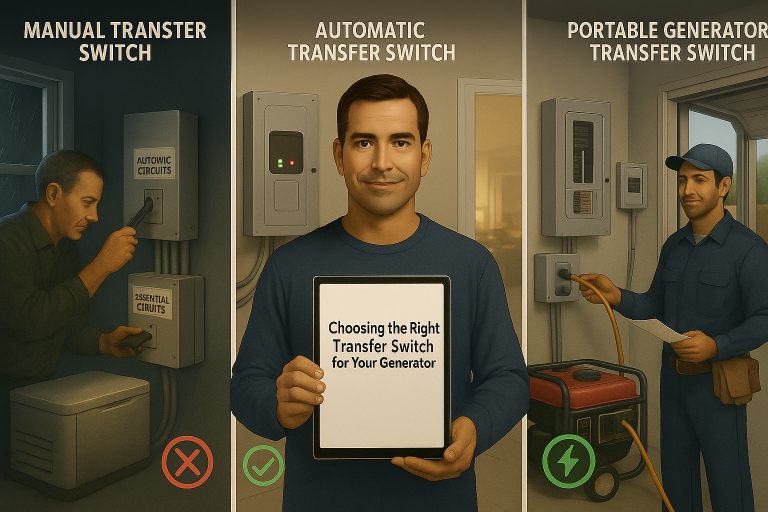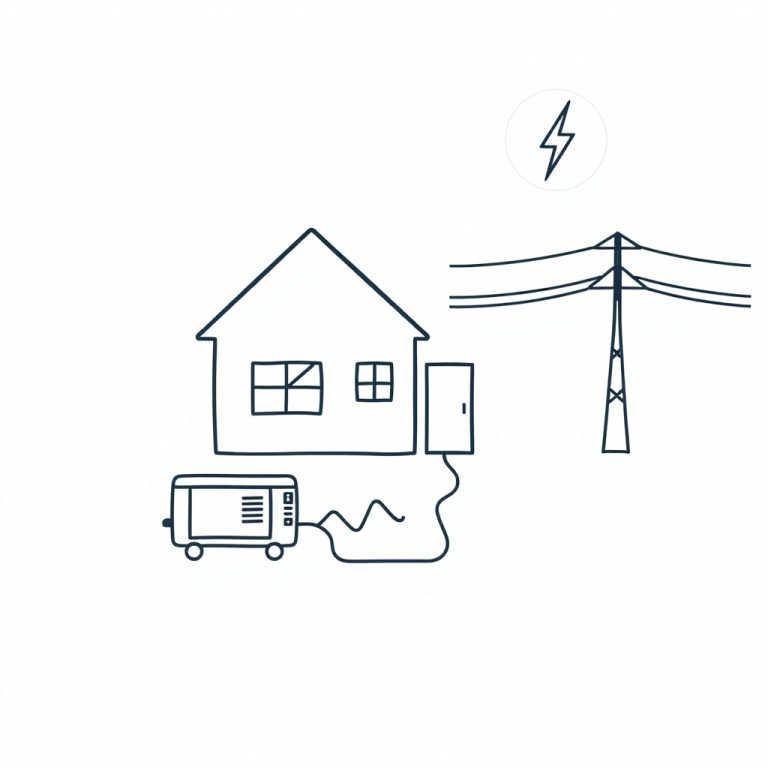How to Choose the Right Size Generator for Your Home
Choosing the right size generator for your home is crucial for ensuring you have reliable power during outages without overspending on a unit that’s too large or inefficient. A generator that’s too small won’t power all your essential appliances, while one that’s too large may be unnecessarily expensive and waste fuel. This comprehensive guide walks you through everything you need to know—from understanding your power needs to choosing the right generator type and size.
Why Generator Sizing Matters
Proper generator sizing is essential for:
- Efficient operation: A correctly sized generator runs at optimal capacity, maximizing fuel efficiency and longevity.
- Preventing damage: Undersized generators can overload, causing overheating or damage to sensitive electronics.
- Cost-effectiveness: Overestimating your needs means higher purchase and operating costs.
Step 1: Identify Your Power Needs
Begin by listing all the appliances and systems you want to power during an outage. These may include:
- Refrigerator
- Lights
- Microwave
- Electric stove
- Heating or air conditioning
- Sump pump
- Water heater
- Internet modem/router
- TV
- Computer
Calculate Total Wattage
Each appliance has a running wattage (continuous power) and starting wattage (the extra surge power needed to start, especially for motors). Use the table below for rough estimates:
| Appliance | Running Watts | Starting Watts |
|---|---|---|
| Refrigerator | 700 | 2200 |
| Window AC (10,000 BTU) | 1200 | 1800 |
| Sump Pump (1/2 HP) | 1000 | 2000 |
| Lights (10 bulbs) | 100 | 100 |
| Microwave | 1000 | 1000 |
| Electric Water Heater | 4000 | 4000 |
| TV | 200 | 200 |
| Laptop | 60 | 60 |
Add the highest starting wattage to the total running watts to estimate your peak power demand.
Example Calculation:
- Total running watts: 700 (fridge) + 1200 (AC) + 1000 (pump) + 100 (lights) = 3,000 W
- Highest starting wattage: 2200 (fridge)
Total requirement = 3,000 + 2,200 = 5,200 watts
So, you’ll need a generator that can handle at least 5,200 peak watts.
Step 2: Choose the Type of Generator
There are three main types of generators for home use:
1. Portable Generators
- Typically range from 1,000 to 10,000 watts
- Best for powering select appliances
- Run on gasoline, propane, or dual-fuel
- Affordable and mobile
- Must be manually started and connected via extension cords or transfer switches
Best for: Occasional outages and smaller power needs.
2. Inverter Generators
- Quieter and more fuel-efficient than standard portable generators
- Typically 1,000 to 7,000 watts
- Provide cleaner power (ideal for electronics)
- Lightweight and portable
Best for: Small homes or essential electronics during short outages.
3. Standby (Whole House) Generators
- Permanently installed and automatically kick in during outages
- Run on natural gas or propane
- Power an entire house
- Range from 7,000 to 25,000+ watts
- Require professional installation
Best for: Homes with frequent or prolonged power outages, or where full home coverage is needed.
Step 3: Match Generator Size to Power Needs
Here’s a quick sizing guide:
| Wattage Range | Suggested Use | Generator Type |
|---|---|---|
| 1,000–3,000 W | Essentials only (lights, phone, fridge) | Portable or Inverter |
| 3,000–6,000 W | Several appliances (fridge, AC, sump pump) | Larger Portable or Inverter |
| 6,000–10,000 W | Most appliances, not whole home | Heavy-Duty Portable |
| 10,000–20,000 W | Whole home (lights, HVAC, kitchen, water pump) | Standby Generator |
| 20,000+ W | Large homes with HVAC and heavy power demands | Whole House Standby |
Step 4: Consider Fuel Type and Runtime
Different fuels have different costs and availability:
- Gasoline: Common for portable generators; easy to find but has a short shelf life.
- Propane: Clean-burning and storable long-term; requires larger tanks.
- Natural Gas: Unlimited supply if you have a connection; best for standby generators.
- Diesel: Efficient and powerful, but noisier and costlier.
Also consider runtime per tank. A longer runtime means fewer refills and easier management during outages.
Step 5: Choose Between Manual or Automatic Transfer Switch
A transfer switch safely connects your generator to your home’s circuit panel:
- Manual: Requires you to plug in and switch circuits manually.
- Automatic: Detects outages and switches power automatically (used with standby generators).
💡 Pro tip: Never backfeed power through a wall outlet—it’s illegal and dangerous.
Step 6: Account for Future Expansion
If you plan to install new appliances (like an electric car charger or hot tub), choose a generator with extra capacity. A good rule of thumb is to allow for 20% headroom beyond your calculated power needs.
Step 7: Consult a Professional
If you’re unsure about wattage calculations or installation, consider hiring an electrician. They can:
- Perform a load analysis
- Recommend a proper transfer switch
- Ensure safe and code-compliant installation
Conclusion
Choosing the right size generator involves:
- Calculating your total power needs
- Selecting the type of generator that fits your lifestyle and budget
- Matching the wattage capacity to your requirements
- Factoring in fuel type, runtime, and switching methods
By carefully evaluating these factors, you’ll be better prepared for power outages and can enjoy peace of mind, knowing your home will stay lit, safe, and functional—no matter what the weather brings.
FAQs
Q: What happens if I use a generator that’s too small?
A: It may overload, causing power loss, damage to the generator, or harm to your appliances.
Q: Can a generator run my central air conditioning?
A: Yes, but it depends on the generator’s wattage. Most central ACs need 3,000–5,000 starting watts.
Q: How do I connect a portable generator to my home?
A: Use a transfer switch installed by a licensed electrician. Never plug it into a wall outlet.
If you need help sizing a generator for your specific home setup, feel free to share your appliance list and I’ll help you calculate it.





